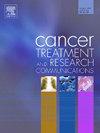Assessing Providers’ knowledge about and barriers to lung cancer screening
Q3 Medicine
引用次数: 0
Abstract
Objective
Low dose computed tomography (LDCT) for lung cancer screening (LCS) is underutilized despite its demonstrated mortality benefit compared to chest radiography. Our study aimed to assess knowledge about LCS and barriers to ordering LDCT from the viewpoint of primary care and pulmonology providers in academic and community settings.
Methods
Providers of various specialties (pulmonology, family medicine, internal medicine, geriatric medicine) who were practicing in Southern California and provided care to patients aged 50 or more were asked to complete a 10-minute survey to assess knowledge about LCS criteria, and barriers to the use of LDCT scan screening. Knowledge scores were calculated for each respondent based on their responses to 9 questions based on Centers for Medicare and Medicaid Services eligibility criteria with a total score range from 0 to 9 points.
Results
32 eligible providers completed the survey, of which none correctly identified all CMS eligibility criteria. Average knowledge score was 6.6 ± 1.1 and did not significantly differ based on practice setting, training level, or years of practice. Common barriers to utilization of LDCT included inaccurate smoking history in the medical record (56.2 %), failure of the medical record to notify providers of eligible patients (43.7 %), and concerns about financial cost of downstream tests after a positive scan (38.7 %).
Conclusions
Suboptimal provider knowledge of LDCT criteria may contribute to LCS underutilization. Improvement of educational resources for providers and augmentation of EMR smart tools to update documented smoking histories and notify providers of eligible patients may improve the rate of LCS.
评估提供者对肺癌筛查的认识和障碍。
目的:用于肺癌筛查(LCS)的低剂量计算机断层扫描(LDCT)尽管与胸部放射摄影相比可降低死亡率,但其利用率却很低。我们的研究旨在从学术和社区环境中的初级保健和肺科医疗服务提供者的角度,评估他们对肺癌筛查的了解程度以及订购低剂量计算机断层扫描的障碍:我们要求在南加州执业并为 50 岁或以上患者提供医疗服务的各专科(肺病科、家庭医学科、内科、老年医学科)医疗人员完成一份 10 分钟的调查,以评估他们对 LCS 标准的了解程度以及使用 LDCT 扫描筛查的障碍。根据每个受访者对 9 个问题的回答,计算出他们对医疗保险和医疗补助服务中心资格标准的了解程度分数,总分范围为 0 到 9 分:32 位符合资格的医疗服务提供者完成了调查,其中没有人正确识别出 CMS 的所有资格标准。平均知识得分(6.6 ± 1.1)分,与执业环境、培训水平或执业年限无明显差异。使用 LDCT 的常见障碍包括病历中不准确的吸烟史(56.2%)、病历未能通知医疗服务提供者符合条件的患者(43.7%),以及对扫描阳性后下游检查的经济成本的担忧(38.7%):结论:医疗服务提供者对 LDCT 标准的认识不足可能是导致 LCS 使用率不足的原因之一。改善医疗服务提供者的教育资源、增强 EMR 智能工具以更新记录的吸烟史并通知医疗服务提供者符合条件的患者,可提高 LCS 的使用率。
本文章由计算机程序翻译,如有差异,请以英文原文为准。
求助全文
约1分钟内获得全文
求助全文
来源期刊

Cancer treatment and research communications
Medicine-Oncology
CiteScore
4.30
自引率
0.00%
发文量
148
审稿时长
56 days
期刊介绍:
Cancer Treatment and Research Communications is an international peer-reviewed publication dedicated to providing comprehensive basic, translational, and clinical oncology research. The journal is devoted to articles on detection, diagnosis, prevention, policy, and treatment of cancer and provides a global forum for the nurturing and development of future generations of oncology scientists. Cancer Treatment and Research Communications publishes comprehensive reviews and original studies describing various aspects of basic through clinical research of all tumor types. The journal also accepts clinical studies in oncology, with an emphasis on prospective early phase clinical trials. Specific areas of interest include basic, translational, and clinical research and mechanistic approaches; cancer biology; molecular carcinogenesis; genetics and genomics; stem cell and developmental biology; immunology; molecular and cellular oncology; systems biology; drug sensitivity and resistance; gene and antisense therapy; pathology, markers, and prognostic indicators; chemoprevention strategies; multimodality therapy; cancer policy; and integration of various approaches. Our mission is to be the premier source of relevant information through promoting excellence in research and facilitating the timely translation of that science to health care and clinical practice.
 求助内容:
求助内容: 应助结果提醒方式:
应助结果提醒方式:


